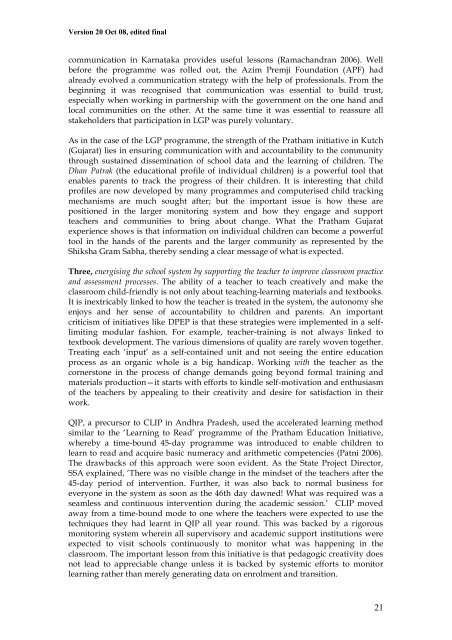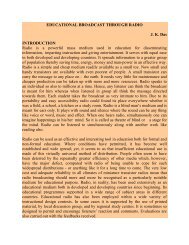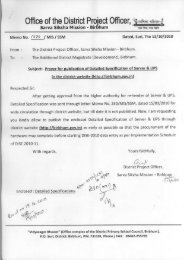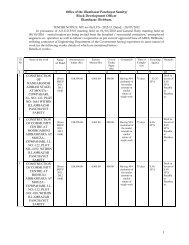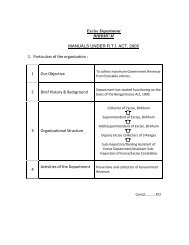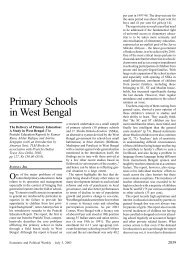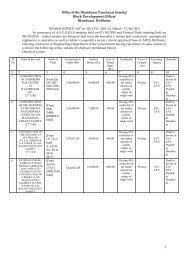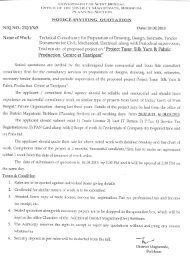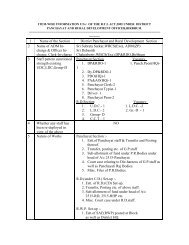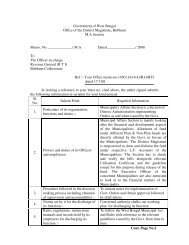primary school teachers the twists and turns of ... - ERU Consultants
primary school teachers the twists and turns of ... - ERU Consultants
primary school teachers the twists and turns of ... - ERU Consultants
Create successful ePaper yourself
Turn your PDF publications into a flip-book with our unique Google optimized e-Paper software.
Version 20 Oct 08, edited finalcommunication in Karnataka provides useful lessons (Ramach<strong>and</strong>ran 2006). Wellbefore <strong>the</strong> programme was rolled out, <strong>the</strong> Azim Premji Foundation (APF) hadalready evolved a communication strategy with <strong>the</strong> help <strong>of</strong> pr<strong>of</strong>essionals. From <strong>the</strong>beginning it was recognised that communication was essential to build trust,especially when working in partnership with <strong>the</strong> government on <strong>the</strong> one h<strong>and</strong> <strong>and</strong>local communities on <strong>the</strong> o<strong>the</strong>r. At <strong>the</strong> same time it was essential to reassure allstakeholders that participation in LGP was purely voluntary.As in <strong>the</strong> case <strong>of</strong> <strong>the</strong> LGP programme, <strong>the</strong> strength <strong>of</strong> <strong>the</strong> Pratham initiative in Kutch(Gujarat) lies in ensuring communication with <strong>and</strong> accountability to <strong>the</strong> communitythrough sustained dissemination <strong>of</strong> <strong>school</strong> data <strong>and</strong> <strong>the</strong> learning <strong>of</strong> children. TheDhan Patrak (<strong>the</strong> educational pr<strong>of</strong>ile <strong>of</strong> individual children) is a powerful tool thatenables parents to track <strong>the</strong> progress <strong>of</strong> <strong>the</strong>ir children. It is interesting that childpr<strong>of</strong>iles are now developed by many programmes <strong>and</strong> computerised child trackingmechanisms are much sought after; but <strong>the</strong> important issue is how <strong>the</strong>se arepositioned in <strong>the</strong> larger monitoring system <strong>and</strong> how <strong>the</strong>y engage <strong>and</strong> support<strong>teachers</strong> <strong>and</strong> communities to bring about change. What <strong>the</strong> Pratham Gujaratexperience shows is that information on individual children can become a powerfultool in <strong>the</strong> h<strong>and</strong>s <strong>of</strong> <strong>the</strong> parents <strong>and</strong> <strong>the</strong> larger community as represented by <strong>the</strong>Shiksha Gram Sabha, <strong>the</strong>reby sending a clear message <strong>of</strong> what is expected.Three, energising <strong>the</strong> <strong>school</strong> system by supporting <strong>the</strong> teacher to improve classroom practice<strong>and</strong> assessment processes. The ability <strong>of</strong> a teacher to teach creatively <strong>and</strong> make <strong>the</strong>classroom child-friendly is not only about teaching-learning materials <strong>and</strong> textbooks.It is inextricably linked to how <strong>the</strong> teacher is treated in <strong>the</strong> system, <strong>the</strong> autonomy sheenjoys <strong>and</strong> her sense <strong>of</strong> accountability to children <strong>and</strong> parents. An importantcriticism <strong>of</strong> initiatives like DPEP is that <strong>the</strong>se strategies were implemented in a selflimitingmodular fashion. For example, teacher-training is not always linked totextbook development. The various dimensions <strong>of</strong> quality are rarely woven toge<strong>the</strong>r.Treating each ‘input’ as a self-contained unit <strong>and</strong> not seeing <strong>the</strong> entire educationprocess as an organic whole is a big h<strong>and</strong>icap. Working with <strong>the</strong> teacher as <strong>the</strong>cornerstone in <strong>the</strong> process <strong>of</strong> change dem<strong>and</strong>s going beyond formal training <strong>and</strong>materials production—it starts with efforts to kindle self-motivation <strong>and</strong> enthusiasm<strong>of</strong> <strong>the</strong> <strong>teachers</strong> by appealing to <strong>the</strong>ir creativity <strong>and</strong> desire for satisfaction in <strong>the</strong>irwork.QIP, a precursor to CLIP in Andhra Pradesh, used <strong>the</strong> accelerated learning methodsimilar to <strong>the</strong> ‘Learning to Read’ programme <strong>of</strong> <strong>the</strong> Pratham Education Initiative,whereby a time-bound 45-day programme was introduced to enable children tolearn to read <strong>and</strong> acquire basic numeracy <strong>and</strong> arithmetic competencies (Patni 2006).The drawbacks <strong>of</strong> this approach were soon evident. As <strong>the</strong> State Project Director,SSA explained, ‘There was no visible change in <strong>the</strong> mindset <strong>of</strong> <strong>the</strong> <strong>teachers</strong> after <strong>the</strong>45-day period <strong>of</strong> intervention. Fur<strong>the</strong>r, it was also back to normal business foreveryone in <strong>the</strong> system as soon as <strong>the</strong> 46th day dawned! What was required was aseamless <strong>and</strong> continuous intervention during <strong>the</strong> academic session.’ CLIP movedaway from a time-bound mode to one where <strong>the</strong> <strong>teachers</strong> were expected to use <strong>the</strong>techniques <strong>the</strong>y had learnt in QIP all year round. This was backed by a rigorousmonitoring system wherein all supervisory <strong>and</strong> academic support institutions wereexpected to visit <strong>school</strong>s continuously to monitor what was happening in <strong>the</strong>classroom. The important lesson from this initiative is that pedagogic creativity doesnot lead to appreciable change unless it is backed by systemic efforts to monitorlearning ra<strong>the</strong>r than merely generating data on enrolment <strong>and</strong> transition.21


